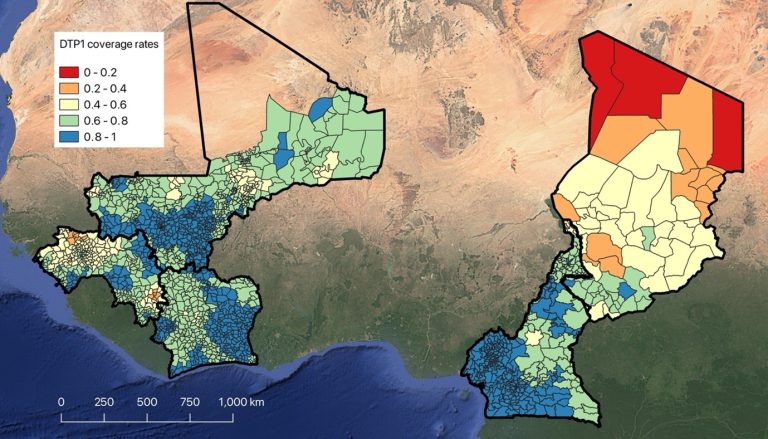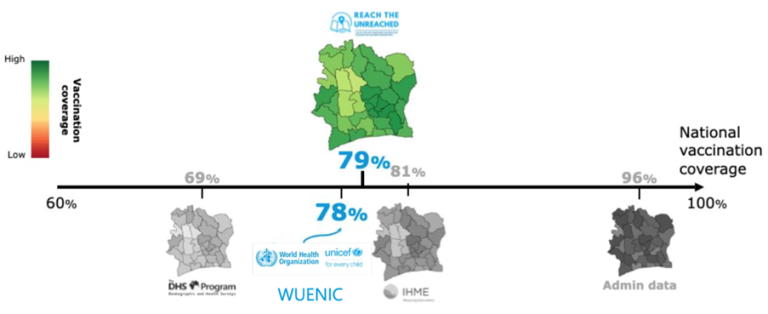By Attila N Lazar and Tim O’Riordan
While global immunisation efforts have seen significant progress, our new high-resolution, digital population and vaccination coverage maps produced for the UNICEF-funded Reach the Unreached project indicate that nearly one million children in five West and Central African countries remain unreached by vaccination services. Despite increased access in many parts of the world, the so-called “last mile” challenge continues to threaten the health of vulnerable children, particularly those in remote or underserved regions.
According to UNICEF’s data (UNICEF, 2023), 108 million children worldwide received the recommended three doses of the diphtheria, tetanus, and pertussis (DTP) vaccine in 2023 – maintaining a global coverage rate of 84%. However, the number of children who did not receive even a single dose rose sharply, from 13.9 million in 2022 to 14.5 million in 2023.
In the 23 countries comprising the whole West and Central African region, UNICEF have estimated that around 6 million of the 20 million children born each year miss out on these life-saving vaccines in their first year of life (UNICEF, 2025). These “zero-dose children” are at particular risk of preventable diseases, often due to systemic challenges in healthcare access.
Bridging the Data Gap with Innovative Mapping
A key barrier to improving vaccination rates in these regions is the lack of accurate, up-to-date population data. Many countries struggle with outdated census information, inaccessible areas due to conflict or climate, and population mobility. To address this, the Reach the Unreached initiative of UNICEF West and Central African Regional Office (WACRO) has delivered a significant step forward in how health services are planned and implemented.
Our team of experts have produced high-resolution, digital population and vaccination coverage maps for Cameroon, Chad, Côte d’Ivoire, Guinea, and Mali. Developed in collaboration with national governments and UNICEF country offices, the maps use advanced geo-statistical modelling techniques, combining satellite imagery with trusted data sources like censuses and household surveys.
These new population estimates – with a spatial resolution as fine as 100 metres – are disaggregated by age and sex, allowing for precise targeting of immunisation services. Vaccination coverage and zero-dose and under-vaccinated children estimates for DTP1-3 were also developed at a 1-kilometre resolution using advanced Bayesian spatial statistical models.
The methodology is tailored to each country’s data context and co-developed with government agencies to ensure reliability and relevance. The results are available in both GIS shapefile and tabular formats to support decision-making at all administrative levels.
Alarming Findings and Impact
The findings from the Reach the Unreached initiative are dramatic: across the five countries studied, an estimated 894,846 children – roughly 25 percent – are completely unvaccinated against DTP, and another 571,218 children (16 percent) are under-vaccinated. Therefore, about 41 percent of all children in these five countries are either unreached or do not receive sufficient levels of DTP vaccine to be effective. While these figures are modelled estimates and subject to the limitations of available input data, especially in countries like Mali and Chad, they emphasise the scale of this urgent public health challenge.
There is no single data source that can tell the truth. For example, UNICEF data confirms that in Côte d’Ivoire, the new modelled estimates (79 percent) align closely with WHO-UNICEF coverage statistics (78 percent). However, other datasets – particularly administrative records – have been found to significantly overestimate vaccination rates, underscoring the importance of using triangulated data sources.

From Data to Action
Data alone, however robust, is not enough. The success of the initiative lies in strong partnerships with governments, humanitarian actors, and technical organisations like MapAction and CartONG. These collaborations have been crucial in turning insights into action through mapping workshops and capacity-building activities.
One clear success story comes from Cameroon. According to Niccolo Cirone, Data Specialist at UNICEF’s WACRO, “The Cameroon field teams were able to use our zero-dose children population estimates confidently, which led to an increase in over 70,000 zero-dose and 100,000 under-immunised children reached.”
Looking Ahead
Although the Reach the Unreached project officially concluded in March 2025, its outcomes are expected to have a long-term impact on immunisation strategies in West Africa. The datasets and documentation are openly available and will continue to support evidence-based planning and humanitarian response.
In the push to leave no child behind, these innovations in data and mapping represent a critical step forward — but sustained effort, investment, and partnership will be needed to reach every child, no matter where they live.
Acknowledgements
The Reach the Unreached project was funded by UNICEF (contract No. 43387656) and led by the UNICEF West and Central Africa Regional Office, in partnership with WorldPop at the University of Southampton, MapAction, CartONG, and national governments.

Downloads
- Modelled estimates and associated documentation (WOPR)
- Technical implementation codes (WorldPop on GitHub)


